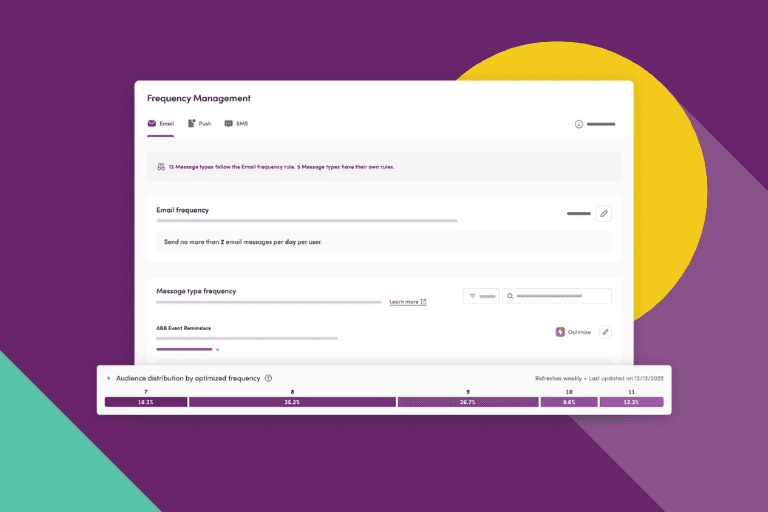Now that we’re in the thick of the holiday season and promotional messaging is ramping up, marketers everywhere are facing the same fear: Are my customers tired of hearing from my brand?
It’s not an irrational concern, given the data:
- 74% of Americans are overwhelmed by the number of messages they receive (MediaPost)
- 59% of consumers say the reason they unsubscribe from emails is because of high frequency (PR Newswire)
- 76% of customers get frustrated if they don’t receive personalized messaging (McKinsey)
Consumers expect brands to communicate with them at the right time, on the right channel, and how often they’re messaged is just as critical to personalization efforts as the content that is being messaged.
Now with Frequency Optimization, a core component of Iterable’s AI Suite, marketers are no longer limited to a manual “one size fits all” approach to sending messages to their audiences.
Here’s everything you need to know about intelligently optimizing your sends to maximize impact.
What is Frequency Optimization?
Iterable’s Frequency Management refers to two features: Frequency Capping and Frequency Optimization.
Frequency Capping allows marketers to set a cap on the number of messages a user receives on a channel or message type.
Frequency Optimization, part of Iterable’s AI Suite, takes capping to the next level. It allows marketers to define a set range for frequency across their message channels and types. From there, AI determines how many messages to send each individual within that capping range.
You can optimize the frequency of email, SMS, and push notifications. This only applies to marketing messages, so you don’t have to worry about customers not receiving important transactional messages, such as password resets and shipping notifications.


Frequency Optimization uses AI to automatically determine the ideal number of messages per user.
Who should use Frequency Optimization?
Fretting over frequency is a universal concern for marketers. You should consider using Frequency Optimization if any of the following issues sound familiar to you:
- Guessing how many messages to send
- Experiencing a spike in unsubscribed
- Trying to determine cadence based on varying levels of user engagement
- Sending at high volumes but struggling with how to prioritize messages
- Having a daily or weekly message mandate without knowing what customers actually want
Marketers at leading consumer brands are already using Frequency Optimization to identify channel thresholds, reduce complaints and unsubscribes, and drive users to take action.
Now you can strike the right balance in actively engaging your customers—without overwhelming them.
What are the benefits of Frequency Optimization?
With Frequency Optimization, there are a host of benefits that a brand can achieve:
- Put marketers in control. Even if AI is steering the wheel, you’re still in the driver’s seat, setting your own capping and optimization ranges. And the insights you glean from historical send data can be used to guide frequency preferences down to the message type.
- Provide a personalized experience. Iterable’s AI Suite determines individual preferences, which are surfaced in the user profile for full customer visibility. You can then evaluate the performance of AI-driven optimization against a holdout group to further tailor a curated customer experience.
- Make your messaging strategy straightforward. By using both capping and optimizations across channels and message types, your messaging strategy becomes more customized—without becoming more complicated.
“We’re able to pick and choose what days, what emails, and what content we want to go to which customer. We didn’t have those capabilities before, and it’s been such a big unlock for us in creating a more advanced program.” ~ Nala Hanna, Retention Marketing Manager at gorjana
How does Frequency Optimization work?
It’s easy to get started with Frequency Optimization. The marketer has the ability to set an ideal optimization range for the message channel (email, push, or SMS) or message type.
Within the next 1-2 weeks, the AI will begin optimizing and assigning the ideal cap per user. You can visit the Frequency Management page to review your audience distribution by optimized frequency, as seen in the image below.


Iterable shows the percentage of your audience that received each number of messages in the range you define.
And don’t forget—you can always override capping rules at the campaign level if you want to ensure a message is sent to all customers regardless of the cap.
To learn more about using Frequency Optimization, review our support documentation and Academy course: Frequency Management.
Make Every Send Count
Marketers don’t want to send more messages than they need to—and consumers definitely don’t want to receive more than they have to. Let AI automatically engage your audience at the perfect moment.
If you’re interested in eliminating all your cadence concerns, our team is here to help.
To test out Iterable’s Frequency Optimization for yourself, reach out and schedule a demo today.
































